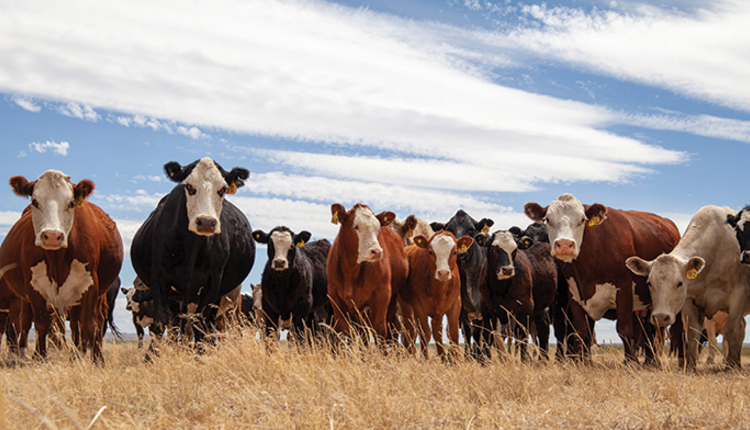
As the western United States again grapples with the effects of widespread fire and crippling drought, supplemental feeding must be considered for beef herds. There is much information available covering cattle raised on native rangelands or improved pastures, and guiding decisions are based either on nutritional quality, economic availability, or some intersection of the two. Let’s focus on one specific strategy to help preserve a productive cow herd and profitable calf crop — supplemental feeding.
First, we need to understand how drought affects pasture forages. Obviously, forage quantity declines — there are fewer plants and less biomass available for cattle to consume. Perhaps less obvious is that forage quality also suffers. Protein levels drop off, as well as total digestible nutrients. In contrast, lignin and other slowly digestible components comprise a greater proportion of the forage biomass. These changes not only reduce the quality of the forage, but also the digestibility, resulting in a triple hit to the cow herd: There’s less grass, it’s of lower quality, and the cow has a harder time digesting it.
When considering supplemental feeding as a strategy to help offset the loss of forage and/or forage quality, there are two main strategies. The first is to feed an energy supplement. Things that fall into this category include feeding hay and/or some type of grain concentrate mix where the primary goal is simply to provide extra energy. The second strategy is to primarily supplement extra protein. Both of these strategies can be successful, but they have specific scenarios where each works best, as well as some drawbacks.
Where forage is scarce
Supplementing energy in the form of hay and/or some type of grain concentrate is best used when you have little to no forage or pasture reserves to draw on. These supplements are generally cheaper to purchase and feed than a protein supplement, although, during drought years, demand may push prices higher than normal. The downside to these supplements are that they need to be fed on a daily basis. This requires more labor. These types of supplemental feedings may also be combined with a protein supplement if low — or poor — quality hay is all that is available.
Another downside to using an energy supplement is known as the substitution effect. When cattle are provided with supplemental hay or grain concentrate, they will preferentially consume that feed source rather than the poorer quality pasture forage that may be available. For those who are grazing public land allotments, be sure to check any associated regulations before feeding an energy supplement. Many agreements do not allow for the feeding of hay, and you may need to move your cattle to a different land base.
Rumen activity and intake slows
If you are fortunate to have a forage reserve, or perhaps were able to find low-cost (but also low-quality) hay, a protein supplement may fit the needs of your operation. When forage protein levels drop below about 6.25%, which is common in more mature or drought-stressed forages, rumen microbe numbers and activity also drop. This significantly lowers forage consumption. By providing a natural protein supplement of at least 22% crude protein, this limiting factor can be removed.
Supplemental protein can enhance the number and activity of rumen microorganisms and boost forage intake (up to 49% has been reported with a 33% protein supplement). While protein supplements are generally more costly, they don’t need to be fed daily like energy supplements. Many protein sources are available in tub or lick form, which can be left out for cattle to consume free choice (salt is used to limit overconsumption), or they can be fed as infrequently as once per week.
Protein supplementation also avoids the substitution effect; in fact, it results in higher consumption of the available forage. This also means that protein supplementation is not an effective strategy if forage resources are limiting. There are some additional benefits to be gained using specific types of protein supplementation, such as rumen bypass protein, especially in extreme drought scenarios or with particularly at-risk cattle. These types of supplements are generally higher cost and only show a benefit beyond traditional protein supplementation in cases where cattle are experiencing extreme and rapid weight loss.
Know your situation
When faced with drought and considering supplemental feeding, first consider if you fit the “energy supplement” scenario (low forage resources) or the “protein supplement” scenario (adequate forage resources but of poor quality). Forage quality testing on either existing pasture forage or hay purchased for feeding can offer further information on the use of energy versus protein supplementation (or a combination of both).
As a final thought, while in a drought scenario, be aware of the potential for toxic plant poisonings. Forages more readily accumulate nitrates following a drought scenario. If you are supplementing cattle with an energy source, don’t suddenly stop when you see pastures greening up. Often the toxic plants are the first to “green up.” Many producers have lost cattle to grazing plants the animals wouldn’t normally consume if their supplemental feed hadn’t been removed too soon.
This article appeared in the November 2020 issue of Hay & Forage Grower on page 22.
Not a subscriber? Click to get the print magazine.

